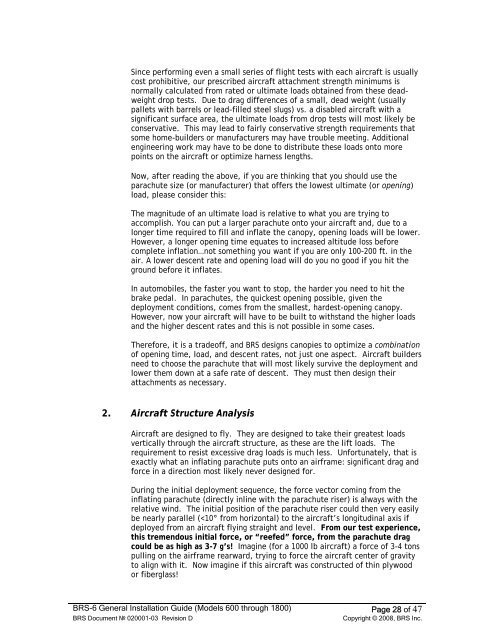BRS-6 General Installation Guide - CAFE Foundation
BRS-6 General Installation Guide - CAFE Foundation
BRS-6 General Installation Guide - CAFE Foundation
Create successful ePaper yourself
Turn your PDF publications into a flip-book with our unique Google optimized e-Paper software.
Since performing even a small series of flight tests with each aircraft is usually<br />
cost prohibitive, our prescribed aircraft attachment strength minimums is<br />
normally calculated from rated or ultimate loads obtained from these deadweight<br />
drop tests. Due to drag differences of a small, dead weight (usually<br />
pallets with barrels or lead-filled steel slugs) vs. a disabled aircraft with a<br />
significant surface area, the ultimate loads from drop tests will most likely be<br />
conservative. This may lead to fairly conservative strength requirements that<br />
some home-builders or manufacturers may have trouble meeting. Additional<br />
engineering work may have to be done to distribute these loads onto more<br />
points on the aircraft or optimize harness lengths.<br />
Now, after reading the above, if you are thinking that you should use the<br />
parachute size (or manufacturer) that offers the lowest ultimate (or opening)<br />
load, please consider this:<br />
The magnitude of an ultimate load is relative to what you are trying to<br />
accomplish. You can put a larger parachute onto your aircraft and, due to a<br />
longer time required to fill and inflate the canopy, opening loads will be lower.<br />
However, a longer opening time equates to increased altitude loss before<br />
complete inflation…not something you want if you are only 100-200 ft. in the<br />
air. A lower descent rate and opening load will do you no good if you hit the<br />
ground before it inflates.<br />
In automobiles, the faster you want to stop, the harder you need to hit the<br />
brake pedal. In parachutes, the quickest opening possible, given the<br />
deployment conditions, comes from the smallest, hardest-opening canopy.<br />
However, now your aircraft will have to be built to withstand the higher loads<br />
and the higher descent rates and this is not possible in some cases.<br />
Therefore, it is a tradeoff, and <strong>BRS</strong> designs canopies to optimize a combination<br />
of opening time, load, and descent rates, not just one aspect. Aircraft builders<br />
need to choose the parachute that will most likely survive the deployment and<br />
lower them down at a safe rate of descent. They must then design their<br />
attachments as necessary.<br />
2. Aircraft Structure Analysis<br />
Aircraft are designed to fly. They are designed to take their greatest loads<br />
vertically through the aircraft structure, as these are the lift loads. The<br />
requirement to resist excessive drag loads is much less. Unfortunately, that is<br />
exactly what an inflating parachute puts onto an airframe: significant drag and<br />
force in a direction most likely never designed for.<br />
During the initial deployment sequence, the force vector coming from the<br />
inflating parachute (directly inline with the parachute riser) is always with the<br />
relative wind. The initial position of the parachute riser could then very easily<br />
be nearly parallel (

















